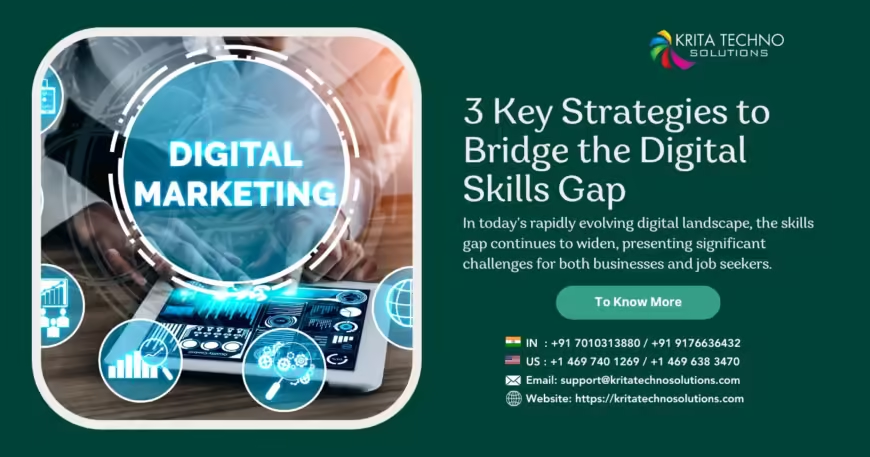In today’s rapidly evolving digital landscape, the skills gap continues to widen, presenting significant challenges for both businesses and job seekers. As technology advances, the demand for digital skills has surged, leaving many industries struggling to find qualified talent. Bridging this gap is crucial for ensuring economic growth and competitiveness. Here are three key strategies to bridge the digital skills gap effectively.
With 12+ years of experience in the industry and a wealth of knowledge about the latest Web technologies, media trends and best practices, we are well-equipped to help you achieve your marketing goals.
1. Invest in Comprehensive Digital Training Programs
One of the most effective ways to address the digital skills gap is by investing in comprehensive digital training programs. These programs should be designed to cater to various skill levels, from beginners to advanced learners. Here’s how organizations and educational institutions can achieve this:
Collaborate with Industry Experts: Partnering with industry experts and tech companies can provide valuable insights into the current demands of the job market. This collaboration ensures that the training programs are relevant and up-to-date.
Offer Flexible Learning Options: Providing flexible learning options, such as online courses, part-time classes, and boot camps, allows individuals to upskill or reskill at their own pace. This flexibility is especially important for working professionals who need to balance their education with their job responsibilities.
Incorporate Hands-On Learning: Hands-on learning experiences, such as internships, apprenticeships, and project-based assignments, help learners apply theoretical knowledge to real-world scenarios. This practical approach enhances their problem-solving skills and prepares them for the workforce.
2. Promote Lifelong Learning and Continuous Education
Promoting a culture of lifelong learning and continuous education is essential for keeping pace with technological advancements. Organizations and governments can play a significant role in encouraging individuals to continually update their digital skills. Here are some strategies to foster this culture:
Provide Incentives: Offering incentives such as tuition reimbursement, scholarships, and learning stipends can motivate employees to pursue further education. Recognizing and rewarding those who take the initiative to upskill can also reinforce the importance of continuous learning.
Develop Career Pathways: Creating clear career pathways that outline the skills and qualifications needed for advancement can guide employees in their learning journey. This transparency helps individuals understand the value of acquiring new digital skills and how it can impact their career growth.
Encourage Peer Learning: Establishing mentorship programs and peer learning groups can facilitate knowledge sharing within the organization. Experienced employees can mentor newer team members, creating a supportive learning environment and fostering collaboration.
3. Leverage Technology to Enhance Learning and Accessibility
Leveraging technology to enhance learning and accessibility is critical in bridging the digital skills gap. By utilizing innovative tools and platforms, organizations can reach a broader audience and provide more effective training. Here’s how to implement this strategy:
Use AI and Machine Learning: AI and machine learning can personalize the learning experience by tailoring content to individual needs and learning styles. These technologies can identify skill gaps and recommend targeted training, making learning more efficient and effective.
Implement Virtual and Augmented Reality: Virtual and augmented reality can create immersive learning environments that simulate real-world scenarios. This technology is particularly useful for technical training, allowing learners to practice complex tasks in a safe and controlled setting.
Expand Access to Digital Resources: Providing access to a wide range of digital resources, such as e-books, webinars, and online tutorials, ensures that individuals have the tools they need to learn. Creating a centralized digital library can make these resources easily accessible to all employees.
Bridging the digital skills gap requires a multifaceted approach that includes investing in comprehensive training programs, promoting lifelong learning, and leveraging technology to enhance learning and accessibility. By implementing these key strategies, organizations can equip their workforce with the necessary digital skills to thrive in an ever-changing technological landscape. In turn, this will drive innovation, boost productivity, and ensure long-term economic success.
Contact us :
📞 IN : +91 7010313880 / +91 9176636432
📞 US : +1 469 740 1269 / +1 214 705 2058
✉️ Email: support@kritatechnosolutions.com
🌐 Website: https://kritatechnosolutions.com/






